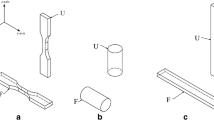Abstract
Inspired by the concept of deploying 3D printers into the field to produce parts on demand, the purpose of this study is to examine the effects of the environment on a 3D printing apparatus and its ability to produce consistent operative prints. The inelastic deformation behavior of Poly-lactic Acid, a biodegradable thermoplastic, 3D printed in extreme environments was investigated. The experimental program was specifically designed to explore the influence of ambient temperature (25–40 °C) during the printing process on the mechanical performance of the printed material. In order to understand the effects of the printing environment versus general exposure to extreme environments, samples were also printed at 25 °C and subsequently aged in an oven at temperatures ranging from 30 to 40 °C before mechanical testing. All mechanical testing was performed in standard laboratory temperature and humidity. The influence of the print temperature and oven aging on the elastic modulus, yield stress, strain energy, and tensile stress are all compared. In addition, the capacity to accumulate strain before failure is compared.
Access provided by Autonomous University of Puebla. Download conference paper PDF
Similar content being viewed by others
Keywords
12.1 Introduction
Digitally manufacturing methods, such as 3-D printing, are promoted as revolutionizing engineering design and repair. Using advanced imaging techniques and computer-aided design, efforts are underway in the engineering and technology community to create personalized components ranging from prototypes, repair parts, prosthetics, biological tissue, and even food. This method of production is beneficial because parts need to be readily available on site. Logistically speaking, it is complex and costly to ship a part that is needed for a field repair across the globe in a timely manner. Also, having parts on hand takes up space in transportation. Space that can be utilized more efficiently through printing on site. Hence, the United States military has moved toward placing 3-D printers with deployed troops (including in extreme environments) [1, 2].
To assure long-term durability and structural integrity of the digitally manufactured components created in these extreme environments, a thorough understanding of the environmental effects on a 3-D printing apparatus is essential. Of particular interest is a hostile environment where temperatures are high, as these parts will be printed and utilized in a similar setting. The hot environment causes the filament to be heated prior to being formed into the object which may result in material properties unlike those specified by the manufacturer.
The research objective of this study is to investigate the influence extreme temperatures on the mechanical behavior of 3d-printed polymers. The effects of extreme temperatures during printing is investigated as well as the effect of thermal aging after the printing process is complete. Experimental results generated here will give insight into the changes in the inelastic behavior of the polymer with prior aging time and provide a foundation for extending constitutive equations to capture the effects of prior aging on the deformation behavior. These materials are promoted as revolutionizing engineering design but comprehensive characterization plans are yet to be developed to understand the array of material properties that can be produced during printing. To assure long-term durability and structural integrity of the digitally manufactured components, a thorough understanding of the effects of the exposure to degrading environment on the mechanical behavior of the printed material is essential.
12.2 Methodology
This research project aims to understand the environmental effects on the performance 3-D printed polymers. To obtain reliable comparative results, we used polymer filament printers of the same make and model, ANET A8 Desktop ED Printers from Prusa i3. The print settings included a layer height of 0.2 mm, shell thickness of 1.6 mm and a fill density 100. A pair of identical printers were used in this project. Two AcuRite 00613 Indoor Humidity Monitors where used to monitor the temperature and humidity during the time of printing.
The material printed is a 1.75 mm diameter PLA (poly-lactic acid) Filament manufactured by K-Camel. The material was printed into a dogbone shape following ASTM D638 Type IV (total length = 115 mm, overall width = 19 mm, gage length = 25 mm, width of narrow section = 6 mm). The baseline dogbones were printed in standard laboratory atmosphere (25 °C). The second set of dogbones was printed in an environment with an elevated temperature in sets at 30, 35, and 40 °C. The third set of dogbones was also printed in a standard laboratory environment (25 °C) and subsequently aged at 30, 35, and 40 °C for 5 h and 15 min to match the amount of time that the printing process lasted for the second batch of dogbones.
All three sets of polymers were tested in uniaxial tension on an MTS Criterion Model 43 with a 30kN load cell. All tests were conducted in crosshead control mode with a rate of 0.01 mm/sec. Strains were measured using an MTS Model 634.11 Axial Extensometer. Reported strains and stresses following the engineering definitions, strain = change in gage length/initial gage length and stress = measured force/initial cross sectional area.
12.3 Experimental Observations
Specimens were subjected to displacement-controlled tension-to-failure tests at 25 °C at a constant displacement rates of 0.01 mm/sec. At least three samples were tested at each rate for each dogbone set. The axial stress–strain responses of a representative specimen from the baseline group (printed at room temperature and not aged), group 2 (printed at 40 °C and not aged), and group 3 (printed at room temperature and aged at 40 °C) are all shown in Fig. 12.1.
For the baseline behavior (listed as Room temperature in the figure), the axial stress–strain curves exhibit an overall average quasi-elastic slope (E) upon leaving the origin. The initial elastic modulus (or Young’s modulus) is observed to decrease with oven aging and with printing at elevated temperature. The maximum stress values are observed to increase with both oven aging and with printing at elevated temperature. And the strain at fracture is observed to decrease with both oven aging and with printing at elevated temperature. Current work will result in graphically compiling the results of printing at each of the elevated temperatures in one figure. In addition, the analysis will compile the results of aging at each temperature all in one figure.
Ongoing analysis is quantifying the observed differences in the monotonic tensile behavior in the three sets of conditions outlined above. The elastic slope will be measured from 0 to 1.5% strain. The yield stress will be measured using a 0.002 offset. The maximum stress, the strain at fracture, and the stress at fracture will also be quantified and compared. All of this analysis will analyze the trends comparing the baseline behavior to the samples printed at 30, 35, and 40 °C. The same analysis will compare the trends for samples printed at 25 °C and then aged for 5 h and 15 min at 30, 35, and 40 °C. The results will be compared to elucidate which properties change due to the material being stored in an elevated temperature environment and which properties only change when the actual printing is conducted in the elevated temperature environment.
References
Department of Defense, 3Dprint.com: the voice of 3D printing/additive manufacturing [Online]. Available: https://3dprint.com/tag/department-of-defense/. Accessed 26 Feb 2018
Marines take 3D printed drones from teh lab to the field, Defense Systems [Online]. Available: https://defensesystems.com/articles/2017/05/08/marinecorpprint.aspx. Accessed 26 Feb 2018
Acknowledgements
This research was conducted with the support of the office of Sponsored Projects, Academic Research, & Compliance St. Mary’s University.
Author information
Authors and Affiliations
Corresponding author
Editor information
Editors and Affiliations
Rights and permissions
Copyright information
© 2019 The Society for Experimental Mechanics, Inc.
About this paper
Cite this paper
Torres, J., Onwuzurike, O., McClung, A.J.W., Ocampo, J.D. (2019). Influence of an Extreme Environment on the Tensile Mechanical Properties of a 3D Printed Thermoplastic Polymer. In: Kramer, S., Jordan, J., Jin, H., Carroll, J., Beese, A. (eds) Mechanics of Additive and Advanced Manufacturing, Volume 8. Conference Proceedings of the Society for Experimental Mechanics Series. Springer, Cham. https://doi.org/10.1007/978-3-319-95083-9_12
Download citation
DOI: https://doi.org/10.1007/978-3-319-95083-9_12
Published:
Publisher Name: Springer, Cham
Print ISBN: 978-3-319-95082-2
Online ISBN: 978-3-319-95083-9
eBook Packages: EngineeringEngineering (R0)





